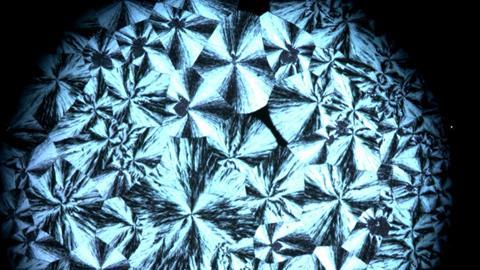Researchers at Eindhoven University of Technology and the University of Cambridge have created an organic semiconductor in which electrons move in a spiral pattern. The light emitted could make OLED screens in televisions and smartphones much more energy efficient. They have published their findings in Science.
Organic semiconductors dominate display technology. The molecular materials they are made of offer a high degree of flexibility for designing unique structures. For some time now, researchers have also been trying to use chiral structures to design semiconductors, in the hope of generating circularly polarised (rotating) light. This light could help displays save a significant amount of energy.
Now, an international team of researchers from Eindhoven University of Technology and the University of Cambridge has succeeded by stacking semiconducting molecules as left- or right-rotating spiral columns. Thanks to their chiral structure, the spiral columns emit a strong green, circularly polarised light. According to co-first author and chemist Marco Preuß (TU Eindhoven), the project demonstrates the importance of international collaboration: ’We in Eindhoven designed the material and Cambridge contributed the physics knowledge to build the device.
Spread out
Most inorganic semiconductors – such as those based on silicon – have a symmetrical internal structure. This allows electrons to move through the material without a preferred direction. Using the organic semiconductor triazatruxene (TAT), the researchers have now succeeded in ‘directing’ the electrons. The TAT material assembles into spiral stacks, allowing electrons to move along the structure like a coil spring.
When blue or ultraviolet light is shone on TAT, the columns emit bright green light with strong circular polarisation. ‘The bound state of an electron and an electron hole on a molecule is called an exciton. When the two come together, light is produced’, says Preuß. ’We discovered that the excitons in our device spread out in a spiral column and thus take on chirality. This gives the emitted light a circular polarisation.
Oil and water
The collaboration between Richard Friend’s group at the University of Cambridge and Bert Meijer’s group at TU Eindhoven had been going on for some time. The breakthrough came when, early in his PhD, Preuß read a paper on a molecule that assembled into achiral columns. ‘I thought that this molecule could be perfect for building chiral columns’, says Preuß. ‘So I synthesised the molecule. But the challenge was to turn it into a chiral thin film that could be incorporated into a device.’
It was at this point that co-first author and physicist Rituparno Chowdhury from the University of Cambridge joined the project. ‘He contributed the physics needed to make an OLED with a working thin film’, says Preuß. ‘Making a chiral material is not that difficult. Making one that does what you want it to do is much more challenging.’
Using the knowledge they had gained, the researchers discovered a surprisingly simple trick. ‘We placed TAT in a host material with a structural mismatch, which caused the TAT to separate like oil and water’, says Preuß. ‘When this was evaporated and heated, the TAT molecules formed segregated domains that crystallised into the chiral spiral columns.’
Unfiltered
The chiral semiconductor could be of great value in display technology. Current displays use a lot of energy because of the way they filter light. Smartphones use anti-reflective filters that capture sunlight, so you can look at your screen outside without the sun overwhelming the brightness of your screen. ‘The problem is that about half of the light emitted by today’s OLEDs is also blocked by these filters’, says Preuß. ‘Circularly polarised light, on the other hand, can easily pass through these filters. This would make the screens much more energy efficient.’
Although the researchers’ device works fantastically, Preuß says it is not yet ready for society. ‘The lifetime is still far too short. While an OLED for industry should be able to last for thousands of hours without losing its function, ours stops working after about a hundred hours. More research is needed to improve this, perhaps in collaboration with industry.’
Chowdury, R. et al. (2025) Science 387(6739), DOI: 10.1126/science.adt3011













Nog geen opmerkingen